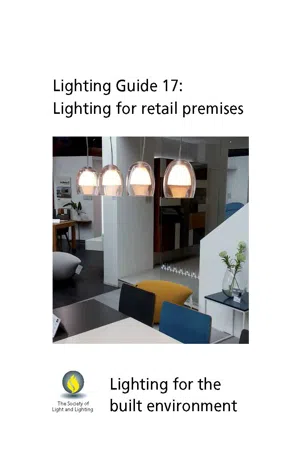
- English
- PDF
- Available on iOS & Android
Lighting Guide 17: Lighting for retail premises
About this book
Lighting within the retail environment has to achieve a number of aims. The obvious and key aim is to highlight merchandise and to use light as a tool to encourage sales. However, it should be remembered that any retail space is also the workplace for members of staff and appropriate lighting needs to be provided for their safety and comfort as well. Colour is an important part of the retail experience and both lighting designers and interior designers will need to work together to provide an environment where colour can be accurately determined. Daylight is being used more than ever in retail spaces, particularly considering the need to reduce energy use and its introduction can result in very different lighting effects.Whilst it is easy to concentrate on the visual effects created in retail lighting, it must provide a level of illumination on all surfaces that can be demonstrated to meet particular workplace legislation such as the Workplace (Health, Safety and Welfare) Regulations 1992, which require workplaces to have suitable and sufficient lighting. Such surfaces are, typically, sales desks, checkout positions, self-pay stations and preparation areas.There are many ways to light a retail space: with direct light from above, from indirect light bounced from the ceiling or from a combination of both. Many factors will dictate or influence the choice of which technique to use. Low ceiling heights or exposed building structure may rule out certain methods or dictate certain layouts. Other building services, such as cooling units or exposed ductwork, may prevent indirect lighting or provide ideal mounting locations for certain types of lighting. The client, interior designer or architect may have strong views on the style of lighting or the lit effect that needs to be created.Designers of lighting for retail environments need to consider the efficiency of both the luminaires to be used and the control system in use. The need for welldesigned lighting is as important as ever and, whilst customers will only be in the space for a relatively short period of time, care should be taken to ensure the long term impact on the staff of any retail space is not compromised in an effort to produce a dramatic lighting effect or to reduce energy consumption at the point of delivery when well-designed and positioned lighting and controls could have a greater influence.The design may either be for a known user or a speculative developer and it may be either a refurbishment or new-build. The following sub-sections outline the design process for each scenario to ensure that the brief has been defined, the relevant information compiled, and the needs of the users considered in relation to the physical constraints of each building type and the needs of the owner or developer.Once the building and its constraints on the design are understood, it is then necessary to select the correct task illuminances for the tasks the staff will carry out in each area and consider the effects of room décor on the lighting and the visual appearance of each space. The sections of this Lighting Guide dealing with designing with daylight and with electric lighting should then be to reviewed.The retail space under consideration may not be in a large, self-contained building but rather in a smaller complex or part of a mixed use building including offices, hotels and residential accommodation, or be a conversion from another use, such as a dwelling.The section on building types outlines some of the special considerations for each of these retail spaces.
Frequently asked questions
- Essential is ideal for learners and professionals who enjoy exploring a wide range of subjects. Access the Essential Library with 800,000+ trusted titles and best-sellers across business, personal growth, and the humanities. Includes unlimited reading time and Standard Read Aloud voice.
- Complete: Perfect for advanced learners and researchers needing full, unrestricted access. Unlock 1.4M+ books across hundreds of subjects, including academic and specialized titles. The Complete Plan also includes advanced features like Premium Read Aloud and Research Assistant.
Please note we cannot support devices running on iOS 13 and Android 7 or earlier. Learn more about using the app.
Information
Table of contents
- Lighting Guide 17: Lighting for retail premises OFC
- Preface
- Contents
- 1 Approach to designing retail lighting
- 2 Types of retail outlet
- 3 Speculative development
- 4 Daylighting
- 5 Electric lighting
- 6 Energy use
- 7 Control of lighting
- 8 Tablet and touch screen displays
- 9 Emergency and standby lighting
- 10 Practical examples of design approaches
- References and bibliography
- Index